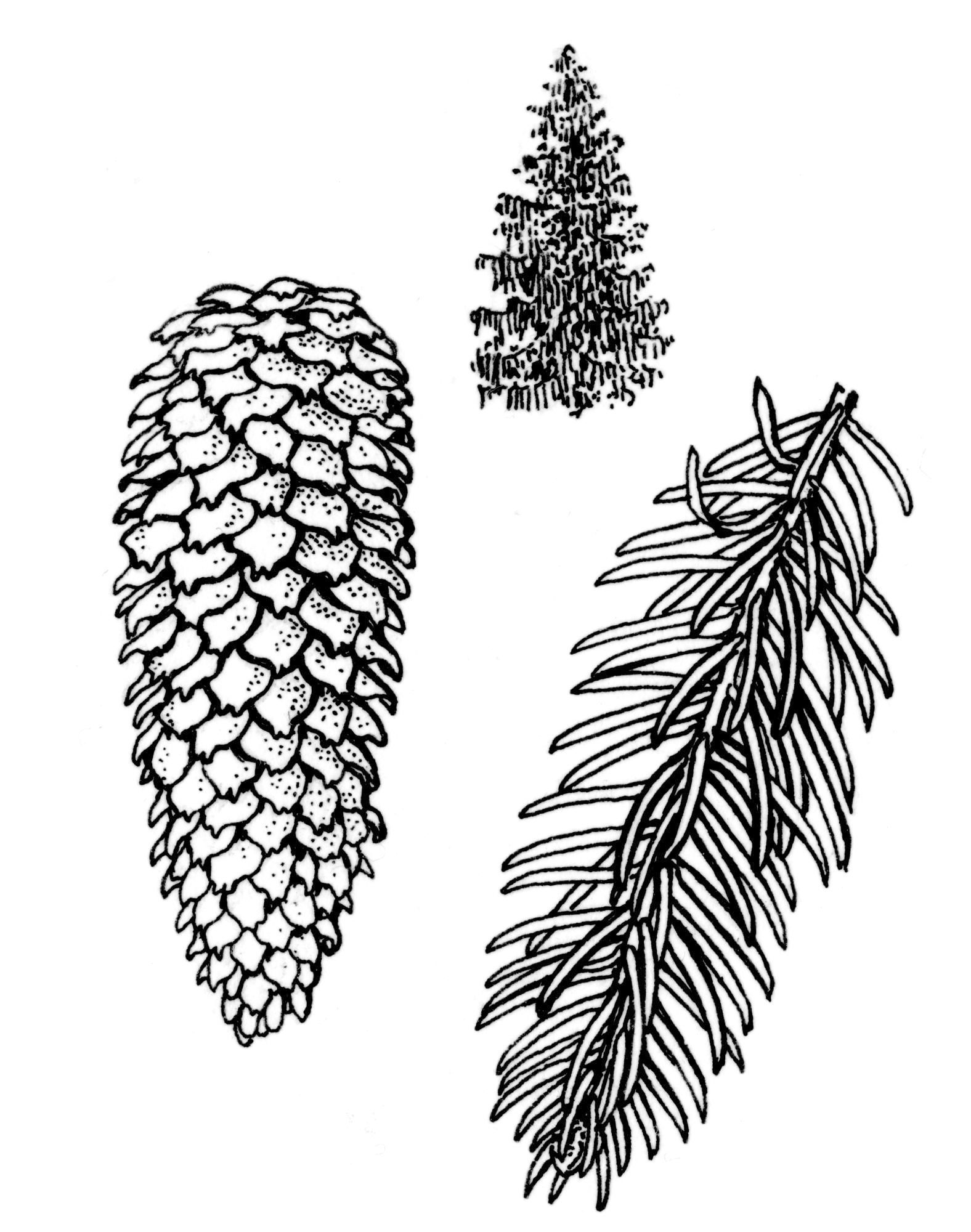
A tall, conical-columnar tree with short branches. Buds conical, pointed, 4-5 mm long, hardly resinous. Young shoots reddish to orange-brown. Leaves mostly 1-2 cm long, slender, acute, pale green, overlapping and pointing forwards on the upper surface of shoot, on the lower surface spreading to expose the shoot surface. Male cones about 1 cm long, yellow. Female cones green when young, pale brown and slightly curved when mature, mostly 10-15 cm long but occasionally longer, cylindrical, tapering to the tip; scales rounded or notched at the tip, slightly wavy edged, more or less rhomboidal, thinly woody. Seed c. 4 mm long, wing about 1.5 cm long.
Grows naturally in N and C Europe in large forests from plains to mountains of alt. 1800 m. Widely cultivated. This is the spruce commonly used as a Christmas tree.
One of the world's most important timber trees.
Leaves mostly pale-green; shoots orange-brown; cones long and tough with shiny brown scales.
NSW: Albury (Bot. Gds); Batlow (Pilot Hill Arboretum); Bundanoon (in front of Bundanoon Hotel, 60 years old in 1993); Mittagong (Albert St, Uniting Church); Orange (Cook Park). ACT: Royal Canberra Hospital; Yarralumla (Nsy ptd c. 1920). VIC: Ballarat (Bot. Gds); Dandenongs (Hamer Arboretum, ptd 1975; 'Pirianda'); Emerald (lake, conifer group above car park, 25 m tall); Korumburra (public park); Maroondah Dam (several 20 m tall); Kyneton (Firth Park, Wombat State Forest); Yackandandah (1 street tree). TAS: Launceston (Cataract Gorge); Plenty (Salmon Ponds). VIC: Dandenongs ('Pirianda').
Source: (1995). Pinaceae. In: . Horticultural Flora of South-eastern Australia. Volume 1, Ferns, conifers & their allies. The identification of garden and cultivated plants. University of New South Wales Press.

Low, widespreading and branches pendulous, the branch tips with contorted cones. Found near Uppsala, Sweden and brought into cultivation in nineteenth century.
Small-growing with creamy foliage. Often found as a seedling variant and probably best treated sa group name.
Dwarf, rounded, extremely slow growing, compact. Discovered on Moira Estate near Belfast c. 1790, later moved by Lord Clanbrassil to his property at Tullymore, County Down and introduced to cultivation by him.
Picea abies 'Compacta Asselyn'
As for 'Compacta' but more condensed and with shorter leaves when young. Origin Netherlands in the 1930s.
Dwarf, conical, broad with lower branches spreading, upper erect. A cultivar name probably referring to a range of clones and therefore probably best treated as a group name.
Dwarf, slow growing, compact, conical. Origin France nineteenth century.
Narrowly columnar tree 10-20 m tall. Found at Fambach, Germany and introduced to cultivation in Germany.
Dwarf, extremely slow-growing, dense, compact but irregular form. Origin Germany nineteenth century.
Dwarf, widespreading, dense, with several upright branches. Originated North America nineteenth century .
Dwarf, extremely slow-growing, dense, round, needles densely arranged c. 8-12 mm long. Rather similar to 'Echiniformis' but without the longer shoots. Origin UK nineteenth century.
Medium-sized with weeping foliage, the branches closely pressed to the stem. Found r. Smith, Kinlet Hall, Shropshire c. 1855.
Dwarf, slow-growing, flattened, globose; leaves close set. Arose as witch's broom on a 'Nidiformis' in Grootendorst nursery at Boskoop, Netherlands c. 1958.
Dwarf, low-growing, compact, outline irregular. American cultivar raised over 100 years ago with several form variants. Originated from grounds of T. C. Maxwell Bros, Geneva, New York, USA, c. 1860.
Dwarf, widespreading with a nest-like hollow in the centre. Raised Rulemann Grisson, nurseryman Sasselheide near Hamburg, Germany.
Dwarf, round becoming conical, branches ascending, branchlets irregular. Raised t. Ohlendorff, Germany c. 1845.
Branches pendulous. A name of uncertain application. Origin believed to be a clone of f. pendula Rehder.
('Prostrata') Quick-growing, flattened, spreading bush, with foliage in flat sprays and exceptionally long leaves. Raised a. Seneclauze, Bour Argental, France, c. 1850.
Habit as 'Pumila' but foliage bluish. Origin UK, nineteenth century.
Like 'Pumila' but with the branches at a steeper angle. Origin Germany nineteenth century.
Dwarf, low growing and widespreading, new growth yellowish and flexible. Origin uk nineteenth century.
Dwarf, extremely slow-growing, dense, compact, new growth greyish and yellow. An old cultivar known in horticulture since c. 1800. Origin UK nineteenth century.
Branches pendulous and needing training or the plant will become prostrate. Origin France nineteenth century.
Dwarf with a regular conical habit and branches spreading, twigs thin. Origin UK nineteenth century.
Dwarf, globular when young, broadening with age, some branches bending down; foliage dark green. Grows 2-3 cm a year. Selected as a seedling by Don Teese; introduced c. 1980.